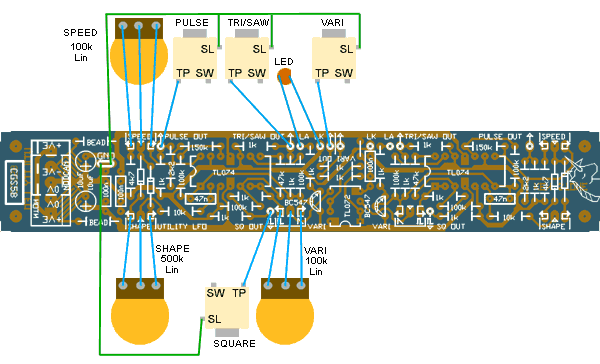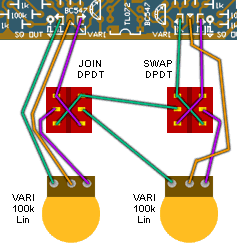|
Utility LFO for music synthesizers. 
This board is a dual utility LFO offering manually variable wave shapes. Standard waveshapes are falling ramp variable through triangle to rising ramp, and variable pulse width. A fixed square is also available, as is a combination waveshape that is variable between the saw/tri output and the square. This is a MIX not a morph. Optional switches allow the variable outputs of the two LFOs to be intermixed. A little on how it works: The Utility LFO is based on the standard integrator/schmitt trigger oscillator core. Two pots in the integrator charge path allow for the adjustment of speed, and along with two diodes, for the adjustment of charge versus discharge time. Changing this ratio will allow the triangle/saw output to be adjusted through falling ramp, to triangle to rising ramp. At the same time, the output of the schmitt trigger will reflect this in the length of it output pulse. A a 0 volt referenced comparator connected to the output of the integrator generates a square wave as there is always an equal portion the ramp/triangle wave above the 0 volt reference, though adjustment of the shape of the ramp/triangle wave does change the phase of this square wave. Following the comparator is a buffered voltage divider to bring the square wave done to a more suitable level and also to drive one side of the variable output mixer pot. The other side of the variable output mixer pot is connected directly to the integrator output. The variable output is buffered is used post mixer by another op-amp. Construction

The component overlay and wiring for one of the two LFOs. Wiring for the second LFO is identical. There is provision on the copper side of the PCB for tacking some extra decoupling capacitors directly across the power rails of the chips, should they be needed. Capacitors in the range of 10n to 100n would be suitable. 
Notes:
Parts list This is a guide only. Parts needed will vary with individual constructor's needs. Article, art & design copyright 2003 by Ken Stone |